| 100-400mm |
$1,600 average price |
|---|---|
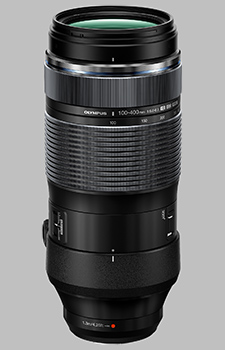
|
|
Your purchases support this site
Buy the Olympus 100-400mm f/5-6.3 IS M.Zuiko Digital ED
Olympus 100-400mm f/5-6.3 IS Field Test
A portable & powerful super-telephoto zoom for the wildlife and nature enthusiast
by William Brawley | Posted 08/04/2020
 |
E-M1 III: 328mm, f/6.3, 1/500s, ISO 640, -0.3EV |
For wildlife photographers out there, Olympus has yet another tempting offering for those who want reach without the weight. For quite some time now the Olympus 300mm f/4 IS Pro was the longest super-tele lens in their modern M.Zuiko lens lineup, providing a powerful but fixed focal length of 600mm-eq. For those wanting some zoom versatility, there really wasn't a high-end option from Olympus themselves. The Olympus 75-300mm is a decent long-zoom with impressive image quality for the price, but the lens lacks weather-sealing and more durable construction, optical image stabilization, and its focal length range skews to a shorter range than most super-telephoto zooms. Meanwhile, the Panasonic 100-400mm Leica was likely the most popular option for MFT shooters wanting a high-end super-tele zoom.
Olympus has finally responded with a 100-400mm zoom of their own. The new M.Zuiko 100-400mm f/5-6.3 IS lens stays true to the Micro Four Thirds ethos of compact and lightweight design while providing a highly versatile 200-800mm-eq. focal length range. What's more, the Olympus 100-400mm is compatible with their pair of teleconverters. Doing the quick math here, adding the MC-20 2x extender gives you a hand-holdable lens with up to 1600mm-eq. of telephoto reach! Add in Olympus' well-respected image stabilization technology, and you have some serious telephoto performance in your hands!
 |
E-M1 III: 723mm, f/6.3, 1/640s, ISO 400, -0.7EV |
One of the major benefits to the Micro Four Thirds platform and its relatively small sensor size is that lens designs can typically be made much smaller and lighter than similar lenses for systems with bigger sensors. And one area where this is perhaps the most noticeable is with super-telephoto lenses. Long telephoto lenses, especially for full-frame cameras, can easily tip the scales at well over five pounds and can approach almost two feet in length with their big lens hoods. Oh, and they are often insanely expensive and well beyond the price range of all but the most dedicated enthusiasts and professionals.
As someone who loves photographing all kinds of wildlife and sports, super-telephoto lenses always catch my eye. At the same time, as someone who, for all intents and purposes, is more of a casual enthusiast in this area and not a full-time pro, I find myself easily gravitating towards the Micro Four Thirds platform for super-telephoto shooting. Not only are these lenses significantly more portable, making them easy to carry with me on a hike, but also, the difference in price for an Olympus super-telephoto like the 100-400mm make them all the more conducive to my budget.
I've been shooting with the new Olympus 100-400mm over the past couple of weeks, so let's jump right in to see how the new Olympus 100-400mm lens performs...
Key Features & Specs
- 100-400mm focal length (200-800mm in 35mm-equivalent terms)
- f/5-6.3 variable aperture range
- 21 elements in 15 groups (4 ED, 2 Super HR, 2 HR elements)
- Compatible with Olympus' 1.4x and 2x teleconverters
- 1.3m minimum focus distance at all focal lengths (0.57x magnification factor at tele)
- Built-in Optical Image Stabilization with 3-stops of correction
- Not compatible with "Sync IS," but can still work in-conjunction with Olympus in-body IS bodies.
- IPX1-rated weather-sealed construction
- $1499.99
Design and Handling
As mentioned, the new Olympus 100-400mm is impressively compact and lightweight for such a long-reaching lens, making it a perfect option for active wildlife shooting while hiking, for example, or simply in other situations where you want to be mobile and flexible with your shooting options and not "tied-down" from lugging around a tripod. True-to-form, the Olympus 100-400mm is significantly more compact and lighter in weight than most other 100-400mm-style super-telephoto zoom lenses for some of the other larger-sensor camera systems.
That being said, it's still a rather large and cumbersome lens by Micro Four Thirds standards, with physical dimensions not too dissimilar from the 300mm f/4 IS Pro lens. With the lens hood attached and the zoom retracted to 100mmm, the lens is very similar in length to the 300mm prime. The lens also feels wider in the hand, with a larger circumference around the zoom ring -- where you'd primarily hold the lens -- compared to the 300mm f/4.
Though very compact compared to competing lenses on larger sensor systems, the M.Zuiko 100-400mm is up there as one of the largest lenses currently available in Olympus' modern Micro Four Thirds lens lineup. Despite its relatively large size, I found the lens to be very easy to carry around, even for long periods. Mounted to the E-M1X most of the time, I found that it balances very well on this larger OM-D body -- no shocker there really. I also used the lens with the E-M1 III and despite this smaller camera body, the lens also feels very comfortable and balanced. The lens didn't feel front-heavy at all, even when zoomed to 400mm and with the lens fully extended. That said, a 100-400mm is certainly not a lens you'd shoot one-handed. Unless I was carrying the camera down by my side, I was always shooting two-handed with the lens securely supported. (But if you ever needed to shoot on-handed, you could do so for brief periods of time!)
Given the fact that this 100-400mm lens includes many of Olympus' top amenities and features, such as several high-performance optical elements, IPX1-rated weather-sealing and being one of the few Zuiko lenses with optical image stabilization, it's surprisingly not designated as a "Zuiko Pro" lens like the 300mm f/4 or the upcoming 150-400mm. When asked about this, Olympus didn't provide a definitive answer; the image quality, as I'll discuss later more, is certainly not a differentiating factor here. What we were told, however, is that the lens didn't get the "Pro" moniker likely due to its variable aperture design. To date, all Zuiko Pro lenses have a constant aperture design, so that answer certainly makes sense.
The 100-400mm does lack a few minor features typically included on Zuiko Pro lenses. The lens lacks the customizable Lens Function (L-Fn) button seen on the side of the barrel, as well as the pull-back "focus clutch" like most of the Zuiko Pro lenses -- instead, it has a standard AF/MF switch on the side. Personally, I'm very prone to accidentally engaging the focus clutch on Olympus lenses, unintentionally putting myself in manual focus mode, so I always disable the clutch mechanism in the camera menu. Needless to say, I don't mind "lacking" this feature.
Other than the 100-400mm's variable f/5-6.3 aperture range, the lens feels more or less like a Zuiko Pro-class lens in the hands, with solid, well-built construction. It's hard to tell for certain about the lens's exact construction makeup, but my sense is when compared side-by-side with the 300mm f/4, that the 100-400mm utilizes more polycarbonate plastic in the barrel construction than the seemingly all-metal 300mm prime. The 100-400mm isn't all plastic, of course -- some of the barrel is clearly metal -- but the interior lens barrel that extends out as you zoom is plastic, as are the focus and zoom rings and the area that houses the panel of switches. This does have weight benefits, or course.
While the build quality of the 100-400mm is generally excellent, my one small complaint would have to be with the small panel of switches on the side of the lens. Once again, I'm comparing things to the Olympus 300mm Pro lens, but the side switches here with the 100-400mm are smaller and somewhat flimsier-feeling in that they are more easily moved by accident. The side switches of the copy of the 300mm Pro I'm using seem to stay in place better and take a bit more effort slide and adjust. While hiking around, I found that when carrying my camera and 100-400mm in my left hand, the most balanced spot to hold this rig is right where the side switches are located. Inevitably, I was often bumping switches by accident, particularly the focus limiter slider switch.
 |
E-M1 III: 210mm, f/6, 1/1600s, ISO 400 (Cropped slightly) |
Image Quality
Featuring a complex optical arrangement with a total of 21 elements, including four ED elements, two Super HR elements and two HR elements, the Olympus 100-400mm doesn't skimp on optical quality, despite lacking the "Zuiko Pro" naming. At IR, we've been exceedingly impressed with Olympus' lens performance when it comes to image quality -- spanning the range from consumer lenses to the Pro ones -- and based on my experience with the 100-400mm in the field, this new lens certainly continues that legacy.
 |
E-M1X: 342mm, f/6.3, 1/1250, ISO 1250 |
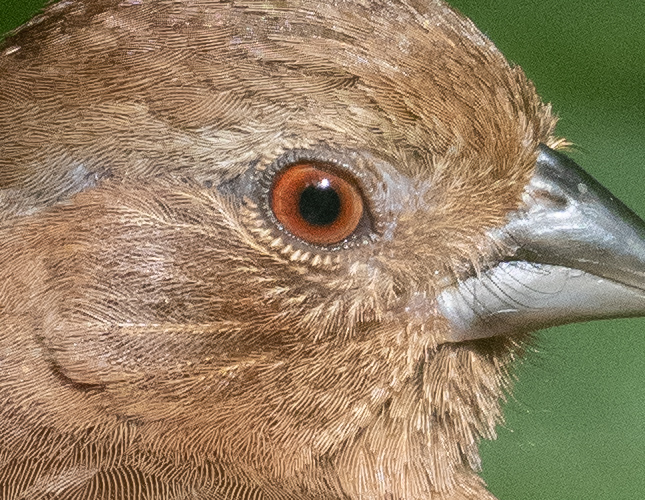 |
100% Crop from RAW file (using ACR default settings) |
On its own, the Olympus 100-400mm produces fantastic quality images, with very sharp detail and overall excellent resolving power, especially if you can get relatively close to your subjects and have good lighting. The fine detail and sharpness of bird feathers and fine animal fur was really impressive. I also observed very little, if any, chromatic aberration and fringing. Only on very rare occasions with some extremely harsh backlit subjects did I see a faint hint of CA. Overall though, CA has been a non-issue in my experience.
Perhaps the primary negative feature of this 100-400mm in terms of image quality performance is its fairly dim variable aperture. The lens's f/5-6.3 aperture range certainly restricts your flexibility in lower light situations. With low-light and High ISO performance being Micro Four Thirds cameras' relative weak spot, I try to keep my maximum ISO level around 1600-3200 when using these cameras. Despite shooting primarily in the mornings and during the daytime, forests and heavily wooded areas are often dimmer than they appear, requiring a higher ISO than you might expect.
 |
E-M1 III: 261mm, f/6.1, 1/320s, ISO 1600 |
 |
E-M1X: 368mm, f/6.3, 1/40s, ISO 1600 |
 |
E-M1X: 285mm, f/6.2, 1/40s, ISO 3200 |
Fortunately, if you're photographing mostly static subjects, Olympus' excellent image stabilization really helps, allowing you to use surprisingly slower shutter speeds (even at super-telephoto distances) and still come away with sharp, blur-free images. That said, the 100-400mm aperture range makes this approach quite difficult; by limiting my high ISO level, shutter speeds were often very slow, especially when shooting at 400mm f/6.3, making blurry images due to camera shake a common frustration. But, if you're patient and steady with your hands, you can you get some good shots, even in lower light situations.
Another, albeit more minor, drawback to the 100-400mm's narrower aperture range is that it (along with the smaller Four Thirds sensor size) makes it more challenging to get a super-shallow depth of field look that is oh so enticing with classic wildlife photos. The super-telephoto focal lengths do, on the other hand, help create a shallow depth of field and good subject isolation, but given the smaller sensor area of Four Thirds and the narrow apertures of the 100-400mm, in many situations, you can't get that super smooth and "creamy" background blur like you could with, say, a 500mm f/4 or 600mm f/4 lens on a full-frame platform. That being said, if you can manage to position yourself so that your subjects is far away from a background, you can get a very pleasingly smooth, blurry background and nice subject isolation. Furthermore, the Olympus 100-400mm has excellent close-focusing performance for such a long lens; you can focus very closely (down to just 1.3 meters even at 400mm). This close-focusing further helps create a shallower depth of field and improved subject isolation.
 |
E-M1 III: 328mm, f/6.3, 1/1600s, ISO 400 |
 |
E-M1 III: 186mm, f/5.9, 1/400s, ISO 400, -0.3EV |
Teleconverters
While a 200-800mm-equivalent zoom range is already extremely versatile and long-reaching, the Olympus 100-400mm supports even more versatility thanks to its compatibility with Olympus' 1.4x and 2x teleconverters. Doing the math, if you combine the 100-400mm with the 2x teleconverter, the result is a 200-800mm zoom, which, in turn, represents a 400-1600mm zoom in 35mm equivalencies. Yes, 1600mm. Handheld. With full autofocus. That is simply an incredible amount of flexibility and versatile telephoto performance in a surprisingly small form-factor.
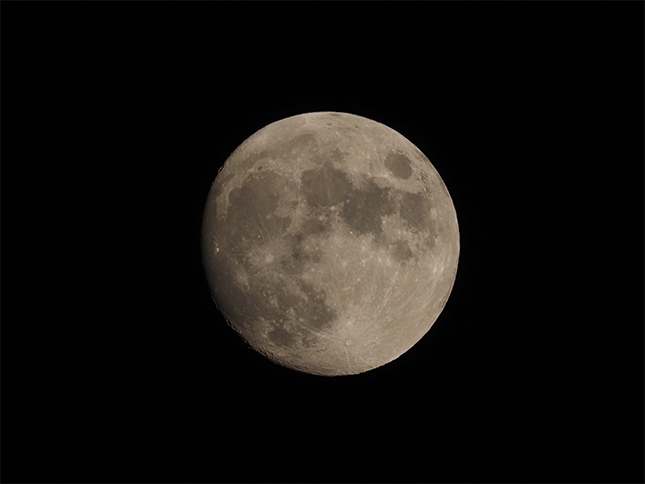 |
E-M1 III + 100-400mm + 2x TC: 800mm, f/13, 1/320s, ISO 640, -0.7EV (Uncropped) |
I found myself using the 2x teleconverter the most when wanting to get more reach (and just that I was curious about the most extreme 1600mm-eq focal length), and despite the additional glass as well as the even-further-narrowed aperture (max aperture with 1.4x is f/7.1-9; 2x is f/10-13), the image quality is still fairly good. At 800mm (1600mm-eq.), the f/13 max. aperture is likely introducing a slight bit of diffraction-related softness, as images didn't seem as tack-sharp as they were with the bare lens. What's more, the narrower apertures require even higher ISOs -- or more light -- in order to prevent blurry shots due to slower shutter speeds. Once more, it was a battle to keep ISOs in-check while still having enough shutter speed to prevent blurring, and it was even more difficult with the longer focal lengths combined with even slower apertures.\
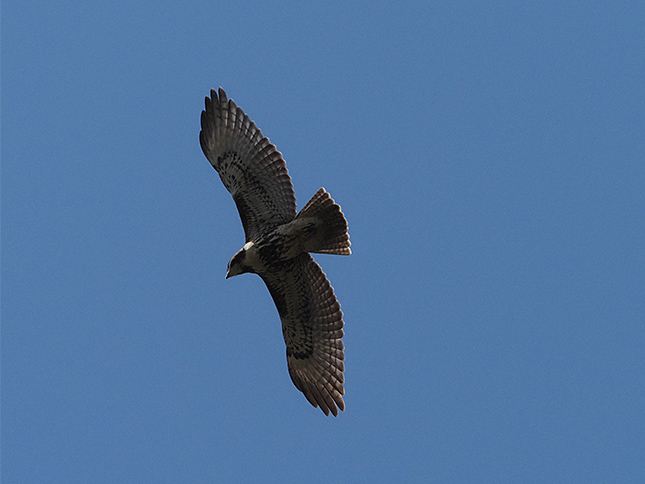 |
E-M1 III + 100-400mm + 2x TC: 490mm, f/12, 1/4000s, ISO 2000, -0.3EV (Cropped slightly) |
Another challenge with such a long-zooming lens, and a factor that's exacerbated with the teleconverters, is that extreme focal lengths can make it difficult to track fast-moving subjects. You have such a narrow field of view, and small movements of the camera are exaggerated at such high magnifications; it's very challenging, especially at 1600mm-eq. to keep your moving subject in the frame and in focus. Plus, despite the fantastic IBIS of the E-M1X and E-M1 III and the onboard optical IS of the lens, the view through the viewfinder can still feel quite shaky at times, especially when using the 100-400mm and 2x TC at maximum zoom and when you're trying to actively pan and move to track in-motion subjects.
Autofocus & Image Stabilization
Autofocus
When it comes to autofocus, the Olympus 100-400mm performed much like other Olympus M.Zuiko lenses, offering very fast, responsive AF. Single-shot AF is nearly instantaneous most of the time when performing short focus shifts. However, as mentioned, the 100-400mm also features rather impressive close-focusing performance for such a long telephoto zoom, at just 1.3m (51.2 inches) across the entire focal length range. As such, it can as bit longer, perhaps only up to a second or so, to shift focus from minimum focusing distance to infinity and vice versa. Continuous AF also worked very in my experience, with good subject tracking performance.
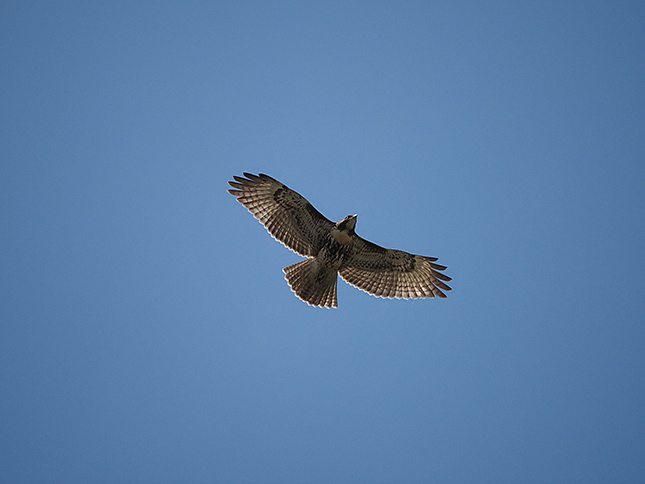 |
E-M1 III: 400mm, f/6.3, 1/6400s, ISO 1000 |
Like most other modern Olympus MFT lenses, the 100-400mm features their MSC ("Movie & Still Compatible") designation, for full-time AF in both stills and video that's also very quiet. The lens's optical construction is designed to use just two small lens elements for focusing, allowing for responsive and fast AF performance.
As with most telephoto zooms, the 100-400mm also includes a focusing limiter switch on the side, allowing autofocus from 1.3m-6m, 6m-infinity, or full-range. In the field, I found the focusing limiter switch quite useful. When tracking birds in flight, I would often switch to the "6m-infinity" limited mode to help prevent the continuous AF from shifting wildly off-base if, or rather when, I lost track of the subject and my AF points moved over blank blue sky.
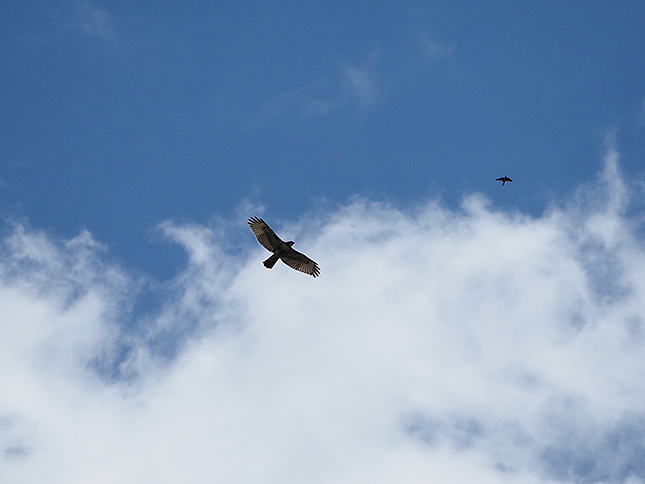 |
E-M1 III: 186mm, f/5.9, 1/16000s, ISO 1600 |
Image Stabilization
With a history and focus on in-body image stabilization, Olympus has typically not offered lenses with optical image stabilization. It was only until recently that Olympus introduced lenses with optical IS, and even then, they currently only have two other lenses with IS: the 300mm f/4 IS Pro and the 12-100mm f/4 IS Pro.
However, the 100-400mm's IS system works a bit differently than Olympus two other optical IS lenses. The 300mm and the 12-100mm feature what Olympus calls "Sync IS," which essentially means that the image stabilization within the camera and lens always work in conjunction with one another -- and it's either on or off. And you can't use just lens IS or body IS when using these two lenses. The 100-400mm, on the other hand, is not 5-axis Sync IS-compatible, and its IS system is independent of IBIS in the camera; you can turn the lens IS and IBIS on or off separately. That said, the two IS systems obviously communicate with each other, otherwise you'd likely be in a world of frustration as the lens IS and body IS fight against each to stabilize your shot.
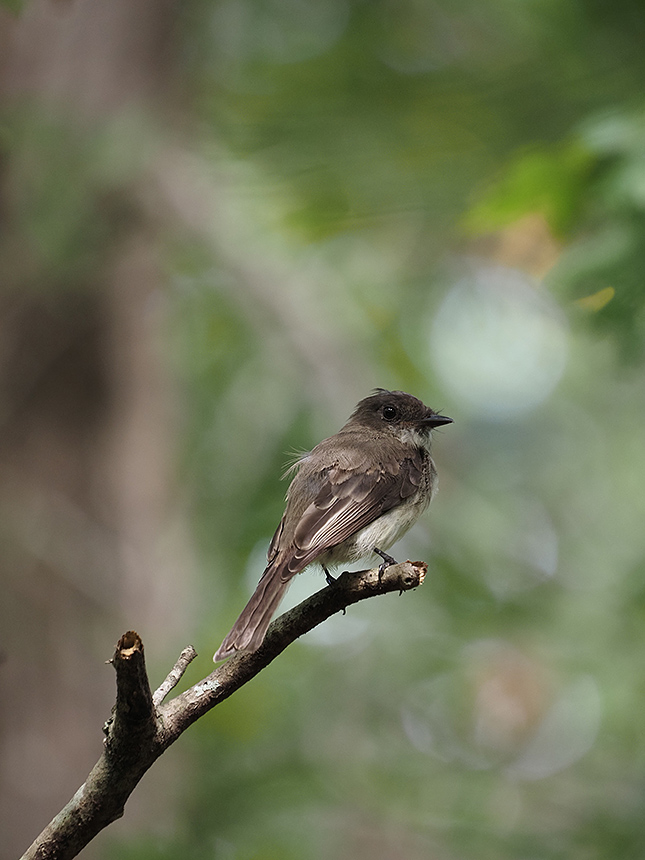 |
E-M1X: 400mm, f/6.3, 1/125s, ISO 800 |
Thanks to the combined Lens IS and IBIS of the E-M1X, I was able to capture a sharp image here at 400mm (800mm-eq.) with a shutter speed of just 1/125s. |
With IS enabled on both the lens and the body, you'll see stabilization benefits from both components: yaw and pitch stabilization from the lens and roll stabilization from the IBIS (as far as we know and according to the specs, X- and Y-shift correction from the IBIS doesn't seem enabled or available with the 100-400mm). Should you want, you can also enable or disable IBIS or Lens IS separately, and to turn IS off entirely, you need to switch it off on the lens and in the camera.
It's a bit confusing, and I'm not exactly sure why Olympus didn't incorporate 5-axis Sync IS compatibility with this lens. I'm speculating here, but perhaps it was for size or cost-saving factors not to utilize the same high-precision gyro sensors as the 300mm? (According to Olympus, they use hand-selected, high-performance gyro sensors inside the 300mm f/4 lens.)
 |
E-M1X: 355mm, f/6.3, 1/40s, ISO 1600 |
Nonetheless, the image stabilization system here with the 100-400mm doesn't feel as powerful or as smooth as the 300mm f/4 IS Pro in my opinion. According to Olympus, the 100-400mm's lens IS is CIPA-rated for just 3-stops of correction, while the 300mm f/4's lens IS offers up to 4 stops by itself or between 6.5-7.5 stops of Sync IS depending on the camera body. Comparing these two lenses side-by-side at 300mm, I found that the 300mm f/4 Pro was ever-so-slightly more responsive, and when looking through the EVF, the IS system seemed to engage and smooth-out the scene quickly and maintained a calm, steady view. With the 100-400mm at 300mm, however, the IS system (lens + the E-M1 III) didn't seem to keep things as steady and smooth. Other times, the view through the EVF seems to stay rather jittery, but if I consciously tried to hold the camera and lens very steady, things would stabilize and smooth out.
Nevertheless, in the field, I'm thrilled to at least have some image stabilization. Given the super-long focal lengths (not to mention when using the teleconverters) and dim aperture range, you really need some stabilization to properly hand-hold a lens like this and get usable shots.
 |
E-M1 III: 400mm, f/6.3, 1/800s, ISO 400, -0.7EV |
Summary
Overall, the M.Zuiko 100-400mm f/5-6.3 IS is yet another impressive lens from Olympus: shockingly compact and lightweight yet packing a punch in the image quality department. If you have enough light. The dimmer variable aperture design is really the only major drawback to the 100-400mm. Given that the Micro Four Thirds system is already at somewhat of a disadvantage at high ISO performance, having a wildlife-centric lens with a slow, variable aperture makes the lens more challenging to use. However, keep in mind the versatility here -- and just how compact and lightweight this particular 100-400mm lens is. Most high-powered zoom lenses have to make design compromises in order to keep the size and weight in check, and the Olympus 100-400 is no different. Heck, most other 100-400mm lenses on the market use a dim, variable aperture design.
If you're a Micro Four Thirds photographer looking for a high-performance wildlife or birding lens and want zoom versatility and/or the price tag of the 300mm f/4 IS Pro is a bit too steep, then the Olympus 100-400mm f/5-6.3 IS should be the top of your list of considerations.
• • •
Olympus 100-400mm f/5-6.3 IS Product Overview
(From Olympus lens literature)
Center Valley, PA, August 4, 2020 – Olympus is pleased to announce the M.Zuiko Digital ED 100-400mm f/5.0-6.3 IS lens, an ultra-compact, lightweight super-telephoto zoom lens that covers a broad telephoto focal length of 200-800mm equivalent1 and is compliant with the Micro Four
Thirds System standard. This lens features the same dustproof and splashproof performance as the M.Zuiko PRO lens series, and when paired with the M.Zuiko Digital 2x Teleconverter MC-20, delivers up to 1600mm equivalent1 super telephoto shooting. This lens offers superior autofocus performance, even handheld, and in-lens image stabilization for the optimal shooting experience.
Compact, Lightweight Design
Despite being a 200-800mm equivalent super telephoto zoom lens, the Olympus M.Zuiko Digital ED 100-400mm f/5.0-6.3 IS lens is compact and lightweight, with a length of 205.7 mm, a weight of 1,120 g6 and a filter diameter of 72 mm. The M.Zuiko Digital ED 100-400mm f/5.0-6.3 IS lens is capable of 200-800mm equivalent1 telephoto shooting on its own, which can be further extended when paired with the optional (sold separately) M.Zuiko Digital 1.4x Teleconverter MC-14 or the
M.Zuiko Digital 2x Teleconverter MC-20, for up to 1600mm equivalent , making it possible to
zoom in close on subjects that are difficult to approach, such as birds and wildlife, and delivering
flattening effects for shooting that is unique to a super telephoto lens. The closest focusing distance across the entire zoom range is 1.3m and the maximum image magnification is 0.57x,
allowing superb telemacro performance when photographing small subjects such as insects and flowers. Focus Stacking is also supported. This feature captures multiple shots at different focal positions and automatically composites a single photo with a large depth of field that is in focus from the foreground to background.
Superb Performance
The optical system of the Olympus M.Zuiko Digital ED 100-400mm f/5.0-6.3 IS lens features a combination of four ED lenses for suppressing color bleeding, two Super HR lenses , and two HR lenses for bright, clear depictive performance to the edges of the image across the entire zoom range. ZERO (Zuiko Extra-low Reflection Optical) Coating is used to reduce ghosting and flaring, for clear image quality, even in poor, backlit conditions. Extensive hermetic sealing on the entire lens barrel delivers the same high level of dustproof and splashproof performance as the M.Zuiko PRO series for peace of mind when shooting in any environment.
Superior Autofocus
A rear focus system is employed to drive this lightweight focusing lens, for fast, high-precision autofocus performance. This lens is also equipped with four functional switches, designed to support handheld shooting, including a Focus Limiter switch for AF operation selection, ranging between three levels, according to the focusing distance, allowing for quick focusing and comfortable shooting, even in the super telephoto range. In-lens image stabilization on/off delivers stable handheld super telephoto shooting, an AF/MF switch and a zoom locking switch.
Pricing & Availability
The Olympus M.Zuiko Digital ED 100-400 f/5.0-6.3 IS lens will be available for $1,499.99 (U.S.)/$2,199.99 (CAD). To pre-order, visit a participating local authorized retailer, or www.getolympus.com. Shipping will begin September 8, 2020.
Olympus 100-400mm f/5-6.3 IS M.Zuiko Digital ED
Your purchases support this site
Buy the Olympus 100-400mm f/5-6.3 IS M.Zuiko Digital ED
Olympus 100-400mm f/5-6.3 IS M.Zuiko Digital ED User Reviews
-
Sharp images, fast autofocusBulky
I have taken many successful images with this lens which has performed better than the equivalent Lumix lens. The Lumix lens is hard to use due to a stiffish zoom ring. It is also not as sharp and cannot be used with some of the cameras features.
reviewed October 15th, 2020 (purchased for $1,600)
This success was achieved by using the focus limiter and increasing the camera's autofocus sensitivity. The later seems beneficial for all the m4/3 lenses I own.
